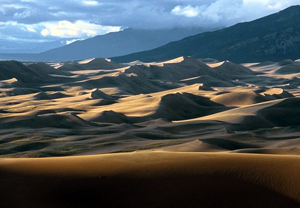By Cris Magnino
When most people mention Colorado, they conjure up images of vast ski resorts, snow-covered peaks, crystal clear streams, remnants of a Gold Rush past, and the lush alpine meadows of the Rocky Mountains. However, hidden away in the southern part of the state is the desert oasis of the Great Sand Dunes National Park and Preserve. Seeming totally out of place at the edge of the snow-covered Rockies lay these dunes of pure golden sand.

The Great Sand Dunes are formed from sand deposited by the Rio Grande and its tributaries, which flow through Colorado’s San Luis Valley. For thousands of years, westerly winds have blown over the Rockies and down over the river flood plain, picking up sand particles along the way. These sand particles are then deposited at the east edge of the valley prior to the wind rising up to cross the Sangre de Cristo range. The sand dunes are naturally-changing sculptures at the mercy of the winds.
The environmental system of the park ranges from the sand dunes to majestic mountain peaks, from cottonwood groves to large stands of aspen, from ancient spruce trees to pine forests, from alpine lakes to tundra, and from grasslands to wetlands -- all habitat which host a wide diversity of wildlife and plant species.
The park is located on the eastern side of the remote, high-mountain San Luis Valley, just 35 miles northeast of Alamosa. Within America’s newest national park stand the tallest sand dunes in  North America, rising some 750 feet above the valley floor. For a truly great experience within the park, follow along the sand ridges until you are standing on the top of High Dune (650 ft.) or Star Dune (750 ft.).
North America, rising some 750 feet above the valley floor. For a truly great experience within the park, follow along the sand ridges until you are standing on the top of High Dune (650 ft.) or Star Dune (750 ft.).
It is a two-mile roundtrip hike for visitors along the ridges but the effort is well-rewarded with spectacular views from the dune summits. Against the backdrop of the rugged Sangre de Cristo mountain range, this 30-square-mile dune field, with no designated trails, invites park visitors to explore freely.
Another amazing feature of the Great Sand Dunes National Park and Preserve happens at Medano Creek. Medano Creek is about 10 miles long and flows heaviest during the spring and early summer.
Fed by melting snow, the creek has its beginning high up in the Sangre de Cristo mountain range. Medano Creek flows on the surface of the sand, which is considered by experts to be a rare hydrologic phenomenon. The creek never finds a permanent or stable streambed, so the clear, warm water constantly changes course and intensity and moves with wavelike ripples across the sand. In peak season, the creek will flow down along the eastern edge of the dunes and then disappear belowground in the valley.
A popular activity for many visitors is to build sand castles out of the creek sand. Nowhere else in Colorado will visitors find such sand quality or quantity. However, during the warm summer months the sand surface temperatures away from the creek can rise above 140 degrees Fahrenheit, much too hot to walk barefoot on.
Whether your interests lie in mountain biking, hiking, playing on the “beach,” having a picnic, sliding down the sand dune slopes, horseback riding, bird watching, viewing wildlife, or maybe just enjoying the quiet splendor of America’s newest national park, the Great Sand Dunes National Park and Preserve offers something for everyone.
The park is open 24 hours a day, year-round. Visitors are encouraged to consult the official website (www.nps.gov/grsa) for complete information.
If you wish to purchase this article for your publication, click here to contact the author directly.